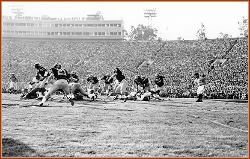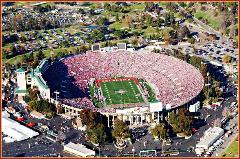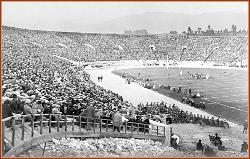Riverfront Stadium
Riverfront Stadium (also known as Cinergy Field) stands on the bank of the Ohio
River. Visible from neighboring Kentucky, it is yet another circular, multi-purpose
stadium with artificial turf and symmetrical outfield fences. Opened in 1970, the
52,392-seat stadium has already hosted five World Series, and was the first baseball
stadium with the now-standard "cut out" infield (dirt only in sliding areas around the
bases), as well as the first to post metric distances on the outfield fences.
Despite its small foul territory and hard playing surface it does not favor batters over
pitchers. The stadium itself sits atop a large underground parking garage, meaning
most fans enter the stadium from below. The original home plate, imported from
Cincinnati's now defunct Crosley Field, was replaced in 1997. An April 17, 1976 game
was delayed when a large swarm of bees descended on the field.
End of the Road Renovation
When the Bengals moved to Paul Brown Stadium in 2000, the Reds
were left as Riverfront's only tenant. Prior to the 2001 baseball season,
the stadium was remodeled into a baseball-only configuration, and the
artificial surface was replaced with grass. To allow room for the
construction of Great American Ball Park (which was being built largely
over the grounds the stadium already sat on), a large section of the left
and center field stands was removed and the distance to the fences was
shortened by five feet. Consequently, in its last years, the stadium
achieved an openness and a degree of aesthetic appeal that it had
lacked for most of its existence. In the Reds' final seasons in the
stadium, ongoing construction on Great American was plainly visible just
beyond the outfield walls while the team played their games.

History
Riverfront Stadium quickly earned a place in Cincinnati's century-long baseball tradition as the home of one of the best teams in baseball
history. The World Series had visited the Reds' previous home, Crosley Field, just three times in its final 31 years, (1939, 1940, 1961) but it
came to Riverfront in its first year (1970) and a total of four times in the stadium's first seven years, with the Reds winning back-to-back
championships in 1975 and 1976. The World Series would return in 1990, with Cincinnati winning the first two of a four-game sweep of the
Oakland Athletics at Riverfront.
Baseball purists disliked Riverfront's artificial turf, but Reds' Manager Sparky Anderson took advantage of it by encouraging speed and line
drive hitting that could produce doubles, triples and high-bouncing infield hits. Players who combined power and speed like Joe Morgan, Pete
Rose and Ken Griffey, Sr. thrived there. On defense, the fast surface and virtually dirtless infield (see photo) rewarded range and quickness by
both outfielders and infielders, like shortstop Dave Concepción who used the turf to bounce many of his long throws to first. Catcher Johnny
Bench and outfielder Tony Perez also played here. The artificial turf covered not only the normal grass area of the ballpark but also what is
usually the "skinned" portion of the infield. Only the pitcher's mound, the home plate area, and cutouts around first, second and third bases had
dirt surfaces. This was the first stadium in the majors with this "sliding pit" configuration. The new stadiums that would follow (Veterans Stadium,
Royals Stadium, Kingdome, Metrodome, Skydome) would install sliding pits as the original layout, and the existing artificial turf fields in San
Francisco, Houston, Pittsburgh, and St. Louis would change to the cut-out configuration in the early to mid-1970s.
Riverfront hosted the MLB All-Star Game twice. First in 1970 with President Richard Nixon in attendance, and again in 1988.









